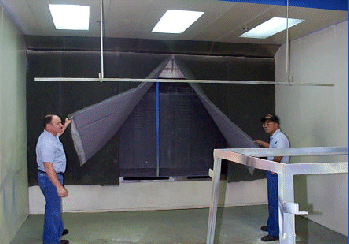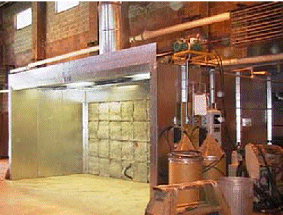| Overview: |
Dry filter systems for paint booths are used to remove paint-based particulates from spray booth air emissions. Their only waste stream is a spent filter containing particulate waste. These systems replace water curtain spray paint booths, which generate large quantities of wastewater and paint
sludge. The wastewater typically requires off-site treatment, and the paint
sludge is frequently disposed as a hazardous waste.
There are many types of dry filter systems,
however, all operate on the same principle: particulate-laden air flowing
towards the filter media is forced to change directions rapidly. The
particulate, having more inertia than the surrounding air, impacts the
filter media and is removed from the airflow. The scrubbed air is vented
into the atmosphere.
Before installing this technology,
several system issues should be considered in the conversion of a paint spray
booth. These issues include characteristics and applicability of dry filter
systems, required fan size, dry filter surface area, paint booth duty
cycles, and paint usage rates. An additional issue for consideration is
the existence and variation of emission regulations in this country.
Generally, the filter system must be chosen such that it meets all local,
state and federal emission regulatory standards. Many types of
dry filter particulate emissions control systems (PECS) and filters are
available.
Four principal types of filters are
currently used: fiberglass cartridges, multi-layer honeycombed paper rolls
or pads, accordion-pleated paper sheets, and clothe rolls or pads. Each
type of filter has different characteristics for particulate capacity,
removal efficiency, cost, and replacement time. Filter performance is
characterized by three basic parameters: particulate capacity, resistance
to airflow, and particulate removal efficiency. Paint characteristics,
such as overspray particulate size distribution, should be compared to the
filter’s performance parameters to obtain an effective match between
components. Filter replacement is required when the filter becomes heavily
laden with captured particulates, resulting in a reduction in removal
efficiency and an increase in the pressure differential across the filter
face.
A filter system gaining prominence in the Air
Force is the Styrobaffle Paint Arrestor. These filters are Styrofoam-like
in composition, and are less expensive, last longer and are easier to
dispose of than traditional fiberglass filters. When these filters are
ready to be disposed, they may be simply dissolved in used paint gun
cleaning solvent, which is then normally recycled.
The waste stream generated in a dry filter
paint booth is a spent filter laden with paint booth particulate
emissions. No other media is contaminated during the collection of the
particulate waste; hence, the quantity of waste generated is minimized in comparison to the water curtain spray paint booth. For
instance, when using lead or zinc chromate paints, the dry filter can
eliminate approximately 50 to 90% of the hazardous waste that is generated
by a water curtain spray paint booth. The removal and replacement of the
spent filters is a simple procedure. The method for disposal of the spent
filters will depend on the particular constituents of the paint used. Many
facilities now segregate operations involving hazardous and non-hazardous
painting into separate paint booths in order to expedite waste handling
and disposal.
The Styrobaffle Paint Arrestors are highly
recommended where applicable and are best used as the first stage of a two
or three-layer air system. However, they do not meet National
Emissions Standards for Hazardous Air Pollutants (NESHAP) requirements
and can not be used where the Aerospace NESHAP requirements are
enforced. The Aerospace NESHAP applies to many, but not all, Air Force bases.
|
| Compliance
Benefit: |
Use of a dry filter paint booth
eliminates the wastewater and paint sludge (i.e., less hazardous waste is
generated) that are generated with a water curtain. This benefit helps
facilities meet the requirements of waste reduction under RCRA, 40 CFR 262; the
Pollution Prevention Act (42 USC 13101-13109); and Executive Order (EO)
13148, Greening the Government Through Leadership in Environmental
Management; and may also help facilities reduce their
generator status and reduce their regulatory burden under RCRA, 40 CFR
262 (i.e., recordkeeping, reporting, inspections, transportation,
accumulation time, emergency prevention and preparedness, emergency
response). In addition, the dry filter paint booth uses less water and
electricity, which helps facilities to meet the water conservation requirements
of EO 13123, Greening the Government Through Efficient Energy
Management. Conversion to a dry filter system may also decrease a facility’s
need for an industrial wastewater discharge permit (local issue).
The compliance benefits listed here are only
meant to be used as general guidelines and are not meant to be strictly
interpreted. Actual compliance benefits will vary depending on the factors
involved, e.g., the amount of workload involved.
|
| Economic
Analysis: |
Converting a water curtain spray
booth to a dry filter paint booth can be easily accomplished and can be
done in-house. The cost of conversion usually ranges from $200 to $2,000,
depending on the size and condition of the old water curtain spray booth.
Purchasing a new dry filter paint booth can cost between $2,000 and
$20,000. The conversion from a water curtain spray booth to a dry filter
paint booth can save several thousand dollars in operating and maintenance
costs per year.
Assumptions (from Columbus Industries,
Inc.):
- Water curtain spray booth is 7’ high, 12’
wide; dry filter booth has 28 modules, each 20"x 20".
- Eight-hour shift, five days per
week.
- Electricity cost: $0.055/kwh.
- Power requirements: water curtain system
uses 15 hp motor, dry filter uses three hp motor.
- Chemical requirements for water curtain
system: 20 lbs/shift.
- Chemical cost: $0.80/lb.
- Filters usage rate: 10/shift.
- Filter cost: $0.62/filter.
- Wastewater generated: 1,000
gallons/shift.
- Wastewater sludge generated: 20
lbs./shift.
- Labor requirements: water curtain requires
12 min./shift, dry filter requires 10 min./shift
- Labor rate: $45/hr.
- Dry filter disposal cost: $1/filter.
- Wastewater disposal cost: $8.24/1,000
gallons.
- Wastewater sludge disposal cost:
$2/lb.
Annual Operating Cost
Comparison for Dry Filter Paint Booth Conversion and Water Curtain Spray
Booth
| |
Dry Filter |
Water Curtain |
| Operational
Costs: |
|
|
| Labor: |
$2,000 |
$2,300 |
| Material: |
$1,600 |
$4,200 |
|
Energy: |
$260 |
$1,300 |
| Waste
Disposal: |
$2,600 |
$12,500 |
| Total
Costs: |
$6,460 |
$20,300 |
| Total
Income: |
$0 |
$0 |
| Annual
Benefit: |
-$6,460 |
-$20,300 |
Economic Analysis Summary:
- Annual Savings for Dry Filter System:
$13,840
- Capital Cost for Diversion Equipment/Process:
$2,000
- Payback Period for Investment in Equipment/Process: < 1
year
Click Here to
view an Active Spreadsheet for this Economic Analysis and Enter Your Own
Values. To return from the Active Spreadsheet, click the Back
arrow on the Tool Bar.
|


